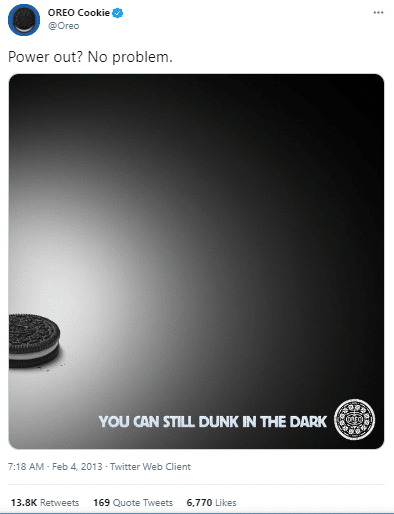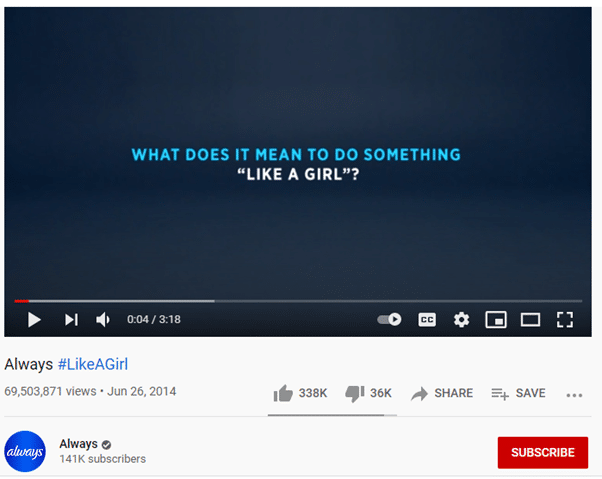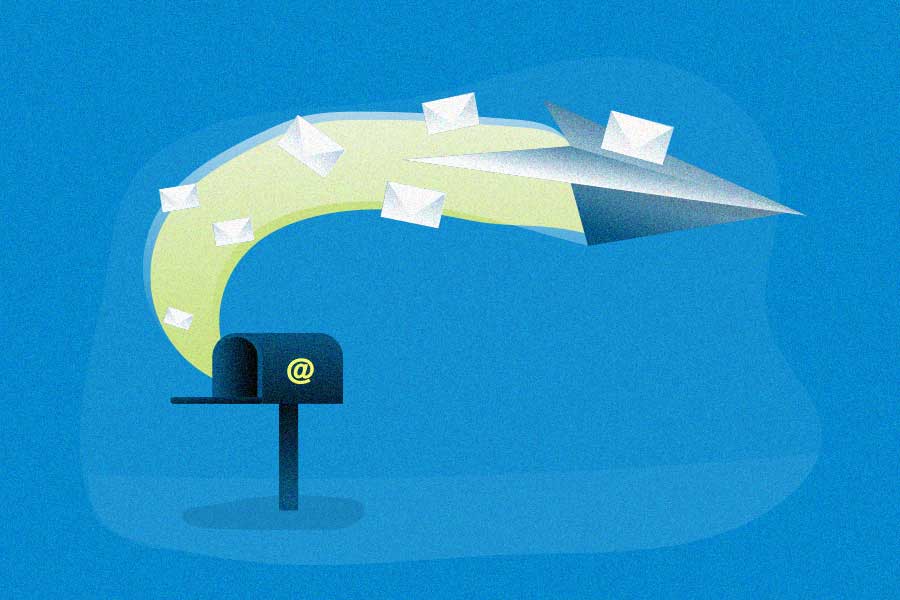Every month there seems to be a new viral video or meme. If you’re a marketer, you’ve likely dreamed of working on a piece of viral content—after all, it could be your claim to fame. But what makes a piece of content a viral marketing hit? Is it all just dumb luck and a bit of creativity? Admittedly, it does take a little bit of both, but behind every piece of viral content is a solid marketing strategy. Here are our favorite successful viral marketing examples to inspire you, plus how you can use this tactic to your advantage.
What’s viral marketing?
Viral marketing is a social media post, or other online marketing tactic, made to encourage rapid and natural social media sharing and amplify word of mouth marketing. Content spreads from user to user like a virus and drops its marketing message along the way.
Viral marketing is branded, but often doesn’t feel like advertising. Instead, it typically takes the form of memes, entertainment-based videos, and compelling visuals.
Even though you can try to engineer a viral social media campaign, the impact is spontaneous and the power is in your viewers’ hands. They have full control over whether the campaign goes viral, so it’s hard to predict whether the campaign will spread. And while you could win big, your campaign might be misinterpreted and cause more harm than good.
The 12 best viral marketing examples
Let’s take a deep dive into some of my favorite examples of viral marketing, and highlight the underlying marketing techniques that made these case studies in virality so shareable.
Visible’s “Free Massages”
Sometimes, landing on a successful viral marketing campaign is all about relatability. We all have that one friend who acts like the grammar police, and low-cost cell phone service provider Visible was counting on it.
Visible knew if they were going to thrive in an overcrowded marketplace, they would have to find a way to cut through the noise and connect with potential customers in a more personal way. To do so, the team came up with a cheeky idea and ran several billboards throughout its headquarters city of Denver, Colorado.
The billboards read loud and clear “Unlimited massages, minutes and data on Visible’s $40/mo phone service.” If you’re like most people, you’ve probably made this mistake in the past, or autocorrect did it for you. Instantly, the typo started getting called out on social media. People were suggesting that Visible should fire their marketing team, or at least hire a new copywriter.
Of course, it was all a plan to drive brand awareness, and a couple of marketers chimed in that they got the joke. A few weeks after launching the billboards, Visible started dropping little hints on social media that they had a surprise planned.
They announced that the typo was intentional on Twitter and informed their followers that they would indeed be offering unlimited massages on September 21 in Denver’s Union Station. By doing so, Visible was able to introduce a cheeky brand voice, while making good on their promise. ![Top 12 Viral Marketing Examples [+ How to Create Viral Buzz] 1 A social media post from brand Visible letting users know that they would be offering free massages](https://referralrock.com/blog/wp-content/uploads/2019/11/2019-11-19_22-38-09.png)
While it’s hard to put a metric on this type of brand awareness, in terms of KPIs, lead generation and service sign-ups topped the list – proving that sometimes it’s best to be transparent. After all, we make typos.
Takeaway
While putting a typo in your ad won’t necessarily help your business, being more transparent will. It might not seem like it, but that was ultimately the goal with Visible’s viral marketing stunt. They wanted to show that they are human and make mistakes like everyone else, but they own them.
By being more transparent with your brand, you can help build trust with your customers, drive innovation in-house, breed honesty among staff, and open yourself up to receive more customer feedback.
Wendy’s Tweets
Wendy’s is known for three things: square burgers, the Frosty, and roasting people on X (Twitter). At the heart of the burger chain’s branding strategy is one central tenet: The people at Wendy’s are serious about their food but not themselves. From releasing a hip-hop mixtape and flirting with celebrities to relentlessly roasting McDonald’s and Burger King online, Wendy’s is the witty friend of the fast-food industry, and there seems to be no limit to their sass.
At the beginning of 2017, Wendy’s had just over 1 million Twitter followers. The brand added 1.2 million new followers by the end of the year, bringing its fan count to 2.24 million. It all started with a simple tweet from Carter Wilkerson that read: “Yo @Wendys, how many retweets for a year of free chicken nuggets?”
Wendy’s reply was meant to be sarcastic: “18 million.” But Wilkerson gladly accepted the challenge and started reaching out for support online, asking people if they would retweet to help him win his prize. His tweet ended up spreading like wildfire as more and more people started retweeting. They were even getting some news sources to join the fun. ![Top 12 Viral Marketing Examples [+ How to Create Viral Buzz] 2 A screenshot of the Twitter conversation between Wendy's and Carter Wilkinson regarding the promise of a year's worth of chicken nuggets](https://referralrock.com/blog/wp-content/uploads/2019/11/2019-11-19_22-31-14.png)
Takeaway
Your brand’s voice comes down to your business’s tone and identity. However, each social media platform has its own unique purpose, and users will have different expectations on each platform.
While your brand’s identity must remain consistent across all channels, you should tweak your message and tone depending on the social network you’re targeting. You should view different social media channels as an opportunity to experiment and show off various aspects of your company’s personality. And injecting a naturally interactive element, by creatively inviting comments and reposts, doesn’t hurt.
OREO’s “Dunk in the dark” tweet
OREO’s “Dunk in the dark” tweet is a clever and spontaneous example of viral marketing that captured attention, and boosted OREO’s reputation, all in one breath. During Super Bowl XLVII in 2013, the Superdome in New Orleans experienced a sudden power outage that left fans literally in the dark. Meanwhile, in the OREO marketing camp, the team seized a golden opportunity and almost immediately released this tweet:

The tweet was retweeted over 13,800 times in a single hour, and garnered over 5,000 other social shares, resulting in phenomenal brand reach. Great marketing is timeless, and this tweet and the OREO brand, in association, get talked about even today.
Takeaway
Speed is often of the essence in marketing. Jump on another viral moment or microtrend in a timely, shareable way, and people are more likely to make your own take go viral as well. An added bonus? It costs hardly anything (there was zero payment involved to spread this tweet).
Just keep your audience’s sense of humor in mind, and don’t post anything that could be seen as distasteful. Plus, make sure your brand has a natural connection to the moment. OREO wasn’t even the first brand to post about the blackout, but their real-time humor and connection resonated best.
“Will it Blend?”
Will it blend or not blend? That is the question. “Will It Blend?” is a YouTube series meant to be an infomercial parody demonstrating the power of the Total Blender, created and hosted by Blendtec founder, Tom Dickson, who attempts to blend random everyday items to show off the power of his blender. And just to be clear, we’re not talking about smoothies here. Tom blends everything from magic markers to iPhones and even an Amazon Echo. ![Top 12 Viral Marketing Examples [+ How to Create Viral Buzz] 3 blendtec-will-it-blend](https://referralrock.com/blog/wp-content/uploads/2019/11/blendtec-will-it-blend.jpg)
Seeing this trend, Blendtec decided to go in a completely different direction, utilizing their unique idea, which has almost nothing to do with traditional blender selling points. Blendtec has been able to build brand awareness in an otherwise nameless market. And in regards to content marketing, Blendtec is by far the most successful company of its kind. Blendtec has topped the charts for kitchen appliances with more than 190,000 Facebook followers, 35,000 X (Twitter) followers, and 850,000 YouTube subscribers.
Takeaway
One thing every start-up can learn from Blendtec is how to find your unique selling proposition (USP). If someone asked you what makes Blendtec so good or unique, the answer would be simple: Their blender can blend anything. But for countless start-ups, this question isn’t so simple.
The secret to unlocking your USP is understanding what your ideal customer wants and making sure you can deliver on what you promise. Sounds simple enough, right? But don’t be fooled, as this exercise is harder than you think. It takes a lot of work, brainstorming, and some trial and error (A/B testing) to see what works. Here are some ideas to help get the juices flowing:
- Narrow your target market
- Solve a problem
- Convenience / Usability
- Reliability/Dependability
- Be innovative
Old Spice’s “The Man Your Man Could Smell Like” campaign
One of the most defining moments in digital marketing history was in 2010, when Old Spice hired an ex-football star, Isaiah Mustafa, for a YouTube ad. The video convinced other mainstream advertisers to push the boundaries if they wanted to connect with the younger generation, even heavily influencing a few different viral marketing campaigns on our list.
The video starts with Isaiah stepping out of the shower, wrapped in a towel, holding a bottle of Old Spice bodywash. Isaiah goes on to perform a series of tasks that would make any woman blush, from taking her on a boat to turning an oyster into a handful of diamonds. The point of it was that your man wasn’t him, but he could smell like him if he stopped using women’s scented bodywash and started using Old Spice. ![Top 12 Viral Marketing Examples [+ How to Create Viral Buzz] 4 Image of ex-football player Isaiah Mustafa on a motorcycle for Old Spice's "The Man Your Man Could Smell Like" campaign](https://referralrock.com/blog/wp-content/uploads/2019/11/old-spice-smell-like-a-man.jpg)
While the video might seem random, Old Spice was brilliant and extremely thorough when it came to targeting their audience for the video. It may seem like they are going for pure shock value or humor, but that’s not the case. The ad was tailored for who was buying the product at the time, which was women purchasing the product for their loved ones. Old Spice was able to do something very difficult: create content that not only stands out but is funny and appealing to their audience’s values.
Takeaway
If you want to create a piece of viral content, avoid the hard sell! Still sell your product, but take a page from Old Spice’s book and invoke some kind of emotion in your campaign, whether that’s joy and laughter (like Old Spice’s ad) or fear, anger, sadness, or disgust.
Squatty Potty’s unicorn video
By now, you’ve probably heard of Squatty Potty, a.k.a. “the stool for better stools,” which is a small, white, inconspicuous stool that rests around your toilet. But no matter how many jokes you crack at it, talking about bathroom humor, let alone the actual process of using the restroom more efficiently, can be a hard sell. But Squatty Potty, with help from the Harmon Brothers, was able to create a viral video about ice cream, Squatty Potty, and a unicorn.
Instead of talking about poop, they talked about soft-serve ice cream, turning poop jokes into marketing gold The result of the joke was the infamous Squatty Potty unicorn ad, in which a tiny magical unicorn explores the benefits of the product while expelling rainbow sherbert ice cream. Without getting into the graphic specifics, it’s goofy, witty, and compelling all at once. The main point of the ad is that the unicorn is excellent at pooping, but you aren’t.
According to the Harmon Brothers, the campaign generated a 400% increase in retail sales, garnered a 600% increase in online orders, and acquired SquattyPotty over a million Facebook shares within the first quarter of launching. By now, the video has over 37 million YouTube views, and still to this day continues to climb. No matter the industry you’re in, a little sense of humor can go a long way. If you take a look around social media, it’s never the soulless infomercials that get shared. It’s the funny videos or the ones that stir emotions.
Takeaway
While humor won’t work for every business, for those with products that you’re trying to make more relatable, there’s no better tool. But you have to stay consistent in your marketing, and make sure it fits your brand. Humor doesn’t work as well if you only use it in one ad.
Dollar Shave Club’s “Our Blades Are F**king Great” video
The Dollar Shave Club’s “Our Blades Are F**king Great” campaign features a number of rarities. Uber-confident CEO Michael Dubin isn’t afraid to take jabs at the way his competitors market and sell their products, while touting why his own company’s blades were so “f**king” great.
Instead of creating a fantastical story or using imagined effects, the campaign stays raw. It’s a real person asking why you’re losing money on $20 a month blades with extras that you don’t really need, when you can switch to Dollar Shave Club and easily have high-quality razors delivered to you for just $1 a month.
The video reportedly only cost$4500 to make, and the returns were astronomical. The Dollar Shave Club’s website crashed thanks to the viral interest created, and when they got it back up the next day, they had over 12,000 new subscribers. The video reportedly garnered over 4 million views within the first few days, and now has over 28 million views.
Takeaway
If you’re disruptive and edgy in the right way (a way that doesn’t turn off your audience), you may have a recipe for virality. Authenticity goes a long way as well, so call out those pain points that you solve and that your competitors aren’t addressing. Dollar Shave Club shows how you can stand out and make yourself memorable, even without the bells and whistles.
Australia Tourism’s Dundee ad
By far the most expensive viral campaign we’ll be covering today, Tourism Australia spent over 36 million on a campaign to make Americans want to visit down under—and broke a lot of Crocodile Dundee fans’ hearts while doing it. YouTube trailers for the new Crocodile Dundee reboot Dundee: The Son Of A Legend Returns had viewers laughing and confused. What was Danny McBride, the star of Eastbound And Down, doing playing the son of Crocodile Dundee alongside Australian A-listers Margot Robbie, Russell Crowe, Chris Hemsworth, and Hugh Jackman? ![Top 12 Viral Marketing Examples [+ How to Create Viral Buzz] 6 Screenshot of YouTube video of ad created for Australia Tourism for the Super Bowl that made a parody Crocodile Dundee reboot movie](https://referralrock.com/blog/wp-content/uploads/2019/11/theres-nothing-like-australia.jpg)
Takeaway
Sure, a lot of viral marketing can be cost-effective. But ometimes you have to spend money to make money. While it’s hard to tell if the campaign accomplished the goal of driving high-valued travelers, one thing is certain: Their ad did drive a lot of exposure. According to the advertising agency Amobee, Tourism Australia’s digital mentions increased by 675% in January of 2018, finishing second for global digital engagement in regards to Super Bowl–related content.
Down under, 50% of Super Bowl ad-related engagement mentioned Tourism Australia. Leading up to the Super Bowl, Amobee found only an 11% difference between engagement for Crocodile Dundee and Tourism Australia, suggesting that the gag trailer drove much of its popularity. If possible, always try and align your content with other trending or popular topics. It’s a great way to give your content a boost and piggyback off of other’s engagement.
ALS Ice Bucket Challenge
I’m sure you remember back in 2014 when you couldn’t hop on social media without seeing a ton of Ice Bucket Challenges. In case you were living under a rock, the challenge involved people dumping buckets of ice water on their heads, sharing a video of them doing it, and nominating friends and family to give it a try to help build awareness for amyotrophic lateral sclerosis (ALS), a progressive disease that causes nerve cells to deteriorate over time and eventually leads to total paralysis and quite often death.
A combination of social currency, challenge, and emotional connections gave the ALS Association’s campaign a life of its own. It’s been compared to a duel, with participants calling out friends and family, making it very hard for them to say no. Social media applied peer pressure to the challenge, convincing more people to step up and participate. ![Top 12 Viral Marketing Examples [+ How to Create Viral Buzz] 7 Video still of MLB Baseball players performing the Ice Bucket Challenge, with one person having a bucket of water poured over their head](https://referralrock.com/blog/wp-content/uploads/2019/11/als-challenge.jpg)
While those might be some real concerns, the numbers speak for themselves. Thanks to the Ice Bucket Challenge, the ALS Association raised over $115 million in donations that year, compared to its previous year of $2.1 million.
Takeaway
While it’s hard to fathom what kind of engagement metrics the Ice Bucket Challenge generated, one driving force that is often overlooked is the challenge. Everyone loves a good challenge—or at least they hate being called out. Throwing that challenge on social media almost makes it impossible to say no. But while you won’t see this tactic very often in B2B or e-commerce, you will see it often in the gaming industry. (Think about posting your high score, or challenging a friend to a game.)
IHOP/IHOb name change
When IHOP announced that they were changing their name to IHOb, without explanation, people were left scratching their heads. Overnight, people started throwing out ideas of what the change could mean. Very few people guessed that the “b” stood for burgers. While not everyone was excited about the big reveal, IHOP felt it was the only way to let people know they take their burgers just as seriously as their pancakes. ![Top 12 Viral Marketing Examples [+ How to Create Viral Buzz] 8 Updated IHOP logo to IHOb with the words "burgers" next to it to explain the change](https://referralrock.com/blog/wp-content/uploads/2019/11/2019-11-19_22-57-52.png)
Takeaway
Sometimes secrets drive word of mouth. Anticipation and mystery are two of the oldest marketing tactics.
Burger King’s bullying and net neutrality videos
Wendy’s might own X (Twitter), but Burger King rules YouTube. Unlike their competition’s use of X as a standup routine, Burger King treats YouTube as their soapbox for providing the masses with funny public service announcements (PSAs).
Their first viral PSA was back in 2017, with the launch of their “Bully Jr” campaign, in honor of National Bullying Prevention Month. The video portrays an alleged social experiment to see how customers would react to the staged bullying of a teenager versus the “bullying” of their Whopper Jr. In the restaurant, a teenage actor was bullied by three other teenagers, while in the back, a Burger King employee bullied their Whoppers (he was punching them). ![Top 12 Viral Marketing Examples [+ How to Create Viral Buzz] 9 A still from Burger King's "bullying" video, showing a man dressed as a Burger King employee](https://referralrock.com/blog/wp-content/uploads/2019/11/burger-king-no-bully.jpg)
A year later, Burger King launched another viral PSA, this time to inform the masses about another issue: threats to net neutrality. The reason this video was so compelling was that Burger King wasn’t trying to sell more burgers or market a new product. They were trying to prove a point to the US government about net neutrality, and did a better job explaining it than Congress.
Once again, Burger King set up hidden cameras and hired actors to teach Whopper buyers a valuable lesson. In the video, patrons are charged more for the same quick service they’ve come to love. But customers who only wanted to pay the regular price of $4.19 would have to wait twice as long for their food. Burger King employees would even intentionally hold their food until the time was up—down to the very last second. ![Top 12 Viral Marketing Examples [+ How to Create Viral Buzz] 10 Video still from Burger King's "Whopper Neutrality" viral PSA video](https://referralrock.com/blog/wp-content/uploads/2019/11/burger-king-whopper-neutrality.jpg)
While the “Whopper Neutrality” campaign wasn’t quite as inspiring as the “Bullying Jr” campaign, they both certainly put the issue in the simplest, most relatable terms for everyday people. Burger King’s viral campaigns have never been about driving sales, just driving awareness, and that’s what makes them so great.
Takeaway
Burger King uses the most relevant topics of the day to create their PSAs. By using topics that are already relevant/trending in the news, Burger King can capitalize on the engagement generated by an already prevalent issue. If you’re focused on growing your business and maximizing traffic to your site, you should create a content calendar that blends both evergreen content—articles that are always relevant—with timely releases that capitalize on another trending topic. While evergreen content is excellent, more popular topics tend to acquire more unique backlinks, which in most cases will only strengthen your site link profile (if from a reliable source), providing you—and your website—a solid foundation for growth.
Always “#LikeAGirl” campaign
One of the more inspirational viral marketing examples was the #LikeAGirl campaign from Always. The campaign focused on challenging stereotypes around the negative usage of the phrase “like a girl,’” as in, “you throw like a girl,” or “you run like a girl.” This video didn’t focus on promoting the Always brand. Instead, it promoted actual social change, with lots of discussions around why doing anything like a girl is nothing to be ashamed of.

Today, the campaign’s main YouTube video has received over 69 million views, over 40,000 comments, and over 300,000 engagements. But even more strikingly, D&AD reported a change in perception with 76% of viewers post-video. 2 out of 3 men, after viewing the ad, even said they would “now think twice before using “like a girl” as an insult.”
Takeaway
Sometimes, as Burger King and Always both found, the best viral marketing campaigns focus on getting people to talk about an issue rather than putting the brand at the forefront. The only branded portion of the Always video was at the end, with a few flashes of the logo and a link to their campaign website! Find and highlight an issue that ties back to your brand in a smart way, and people could also make your brand part of that conversatio for years to come. And be sure to create a campaign hashtag, so you can follow (and keep joining in on) the conversation!
Why viral marketing is worth the risk
What makes viral marketing so powerful is that the exposure pays for itself. You might have to spend a little money in the beginning to get things moving, but once it starts working and interested people start flowing in, you can cut back on your advertising spend.
Plus, the next time you run a campaign, you’re more likely to reach a larger audience thanks to the brand awareness built during your viral campaign. A viral post could generate rapid buzz, but your virality could also slowly pick up speed and compound with each campaign.
A viral campaign is branded but doesn’t feel like an ad. With most viral campaigns, the intention is never to hard sell. Instead, it’s usually about driving brand awareness and giving people something to talk about. The decision to like or share comes down to the user, so it never comes across as invasive.
Viral marketing is trusted, thanks to peer-to-peer sharing. We all know the power of referral marketing, and it’s no different when it comes to viral content. The simple fact that a friend is sharing it increases the chances of your brand being viewed in a positive light.
Viral marketing is one of the quickest ways to build brand awareness. While we typically focus on sales with advertising, there’s no denying the benefits of viral marketing in terms of lead generation. It’s true, most people won’t be ready to buy from you, but they will certainly keep you in mind when the time comes.
The downside to viral marketing
If poorly executed, you can go viral in the wrong way. What may be a positive and fun experience for some could be a negative experience for others. You never know how some people could take your message or sense of humor. Once your campaign is released, it will take on a life of its own and could be impossible to handle.
Viral marketing might not result in long-term loyal customers. Sure, if your piece of viral content is around a product, you might see a huge spike in sales. But more times than not, these new users are just riding the trend and might not even be your ideal customers.
Viral marketing is not very consistent. It’s hard to create viral content, let alone replicate it time and time again. Plus, there’s no way to tell how long a trend will last, making it hard to build a scalable strategy around.
It can also be tough to measure the results of viral marketing, a necessity in scaling your marketing efforts. Since viral marketing can be very hit or miss, there’s no real way to tell what your ROI will be. Some campaigns may catch fire right away, while others could take months even to sizzle, and some won’t gain any traction at all.
Even if you manage to go viral, the nature of the engagement can be hard to measure. After all, how many people just watched your video on their friend’s phone? There’s no way to track that.
How to equip yourself to go viral in the right way?
While the downsides are real, there are viral marketing tools and tactics out there that can help you master the process. Listed below are a few key things to keep in mind while building your campaign.
- Know your target audience: Understanding your audience is marketing 101, but for a piece of content to spread, you have to get it in front of the right people. It’s all about creating content that speaks to your audience and connects with them on an emotional level.
- Make sharing easy: You shouldn’t create content and just pray someone will share it. Instead, you should be proactive and build the sharing of your content into your campaign. It can be something as simple as a referral program or adding share buttons to your blog post.
- Know your goals: Why are you creating this campaign or trying to go viral? Is it to increase your following, drive awareness for a case, strengthen your SEO, or maybe promote a special event? Knowing your endgame will make it easier to analyze and optimize each step of the process.
- Keep your message clear: Keeping content simple and easy to absorb is a crucial element for any marketing campaign. The content you create should get to the point quickly before you lose your audience’s attention. Remember, you only have a few seconds to make an impression.
- Viral content pieces aren’t the norm: They’re the unicorns of marketing. However, they all share similar characteristics that increase their chances of going viral.
Viral marketing vs. viral loop
Sometimes, people use the term “viral loop” to refer to viral marketing, and yes, they are similar. Like viral marketing, viral loops create a cycle of sharing – viewers share the content with friends, who, in turn, share with their friends. But a viral loop iscustomer-acquisition focused. Its goal is to expand your customer base by getting people to refer friends to your business, rather than just creating brand awareness. While viral marketing is less predictable, anyone can create a viral loop if they follow the right methods.
Viral loop example: RobinHood app
While most of the companies we’ve spoken about so far have created some crazy and unique content, Robinhood kicked it old school and focused on designing a seamless referral marketing campaign.
Fear of missing out (FOMO) is one of the oldest and most powerful marketing tactics out there. Instead of launching their product to everyone all at once, Robinhood made the waiting list invite only, appealing to its early adopters’ desire to be the first to benefit from their product/offering.
The process was simple; when a potential user arrived on their landing page, all they had to do was enter their email address to opt in. After signing up, you were put on the waiting list. The higher on the list, the sooner you got to try the app.
Right after entering your email, you were taken to a page that showed your position on the waiting list. Conveniently placed underneath the waiting list was a reward-based invitation to share RobinHood with just one click. The more people you shared with and signed up, the higher you climbed on the waiting list, and the sooner you would gain access. This drove countless people to spread the word about RobinHood and share their link as often as possible.
Since their referral program worked so well, RobinHood continued it in a different form after launch: referrers earned a share of surprise free stock when their friends joined the platform, and gave a surprise free share to their friends as well. The element of surprise created its own viral effect, as users were excited to share on social media when they earned higher-value stock.
Takeaway
A viral loop is one of the most effective ways to drive word of mouth and can be implemented in just about any business. Incentivize people to refer as many people as possible by offering a reward for each new customer that successfully signs up via invite. Robinhood did this through the gamification process, by giving early access to those who referred more (and later, by giving out the surprise free stock). Countless businesses have used referral rewards and gamification to create a viral effect.
Wrap-up
While I hope this information got your creative juices flowing, one thing to always remember is that viral marketing isn’t for every business.
If you’re just starting your company, I would recommend holding off on it. It’s better for smaller and newer companies to use referrals for growth, rather than turning to social media marketing and hoping their post goes viral.
Some of the viral marketing examples above seem like the stars aligned, and they got a lucky break. But that simply isn’t true—every company listed above put a lot of time and effort into building a solid marketing foundation before attempting their viral stunt.
Interested in trying a viral referral loop instead? Reach out to Referral Rock today to start increasing your referrals.

![Top 12 Viral Marketing Examples [+ How to Create Viral Buzz] 5 dollar shave club](https://referralrock.com/blog/wp-content/uploads/2024/06/dollar-shave-club-blades-ad-1.png)
![Top 12 Viral Marketing Examples [+ How to Create Viral Buzz] 11 Image from Robinhood's app advertising the benefits of inviting friends to the app](https://referralrock.com/blog/wp-content/uploads/2019/11/pasted-image-0-7-e1562329430344.png)



